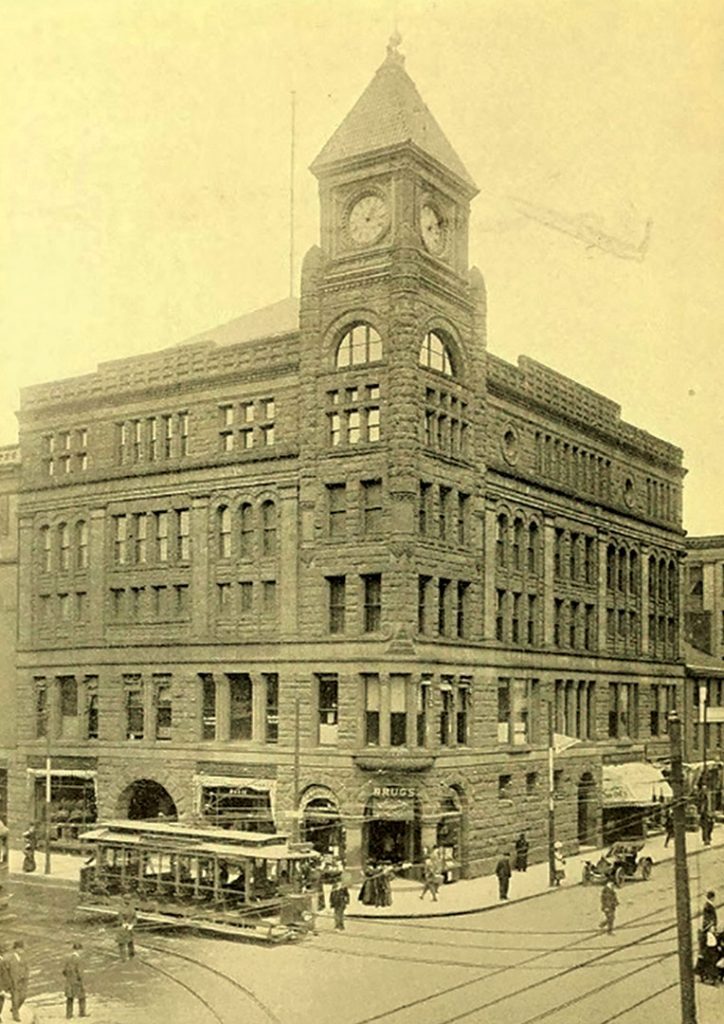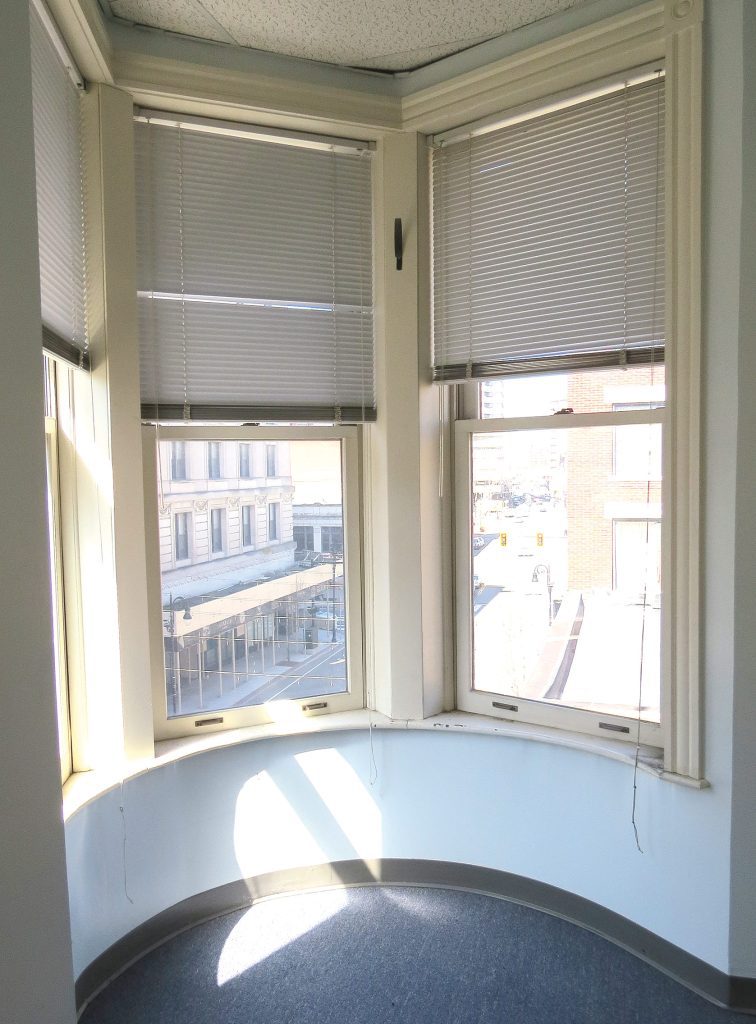Turning Back the Clock

The Clocktower Building, above, was home to Masonic Temple more than a century ago (right).

At other times in Springfield’s history, the properties at 113 State St. and 1155 Main St. were prominent players in the vibrancy, culture, and overall tenor of the City of Homes.
The former — long known, for obvious reasons, as the Clocktower Building — was home to the Masonic Temple when it opened in 1893, before a new, much larger facility was built further east on State Street. The latter, the Colonial Block, which opened in 1903, was one of the city’s first real mixed-use facilities, noted Tim Sheehan, Springfield’s chief Development officer, featuring a blend of office and retail space on the lower floors and residential units on the upper floors.
Until fairly recently, meaning before the pandemic, the two properties had still been somewhat vibrant, featuring a wide array of tenants, including nonprofits, small businesses, a bank (at 113 State St.), and a number of various-sized law firms taking advantage of the buildings’ proximity to the Hampden County Courthouse just down State Street. These days, though, they are almost entirely vacant and stand in stark contrast to the progress seen around them, most notably across Main Street at MGM Springfield and across State Street at the MassMutual Center.
City officials have been looking to change that picture, obviously, and are moving forward with a plan to return these buildings, and also 11-21 Stockbridge St., a smaller, better-occupied office property in that same area, to their former status and make them part of the city’s resurgence. After acquiring them as a package in 2021 for $2.75 million, the Springfield Redevelopment Authority (SRA) has invited the development community to step up and submit proposals for the properties, separately or perhaps collectively.
Responses to this request for qualifications (RFQ) are due later this month — the deadline was originally late March — and Sheehan and SRA Executive Director Amanda Pham are expecting some imaginative proposals because that’s what will be needed to turn back the clock and make them key players again.
“This will require a responsive, creative developer, someone who has a vision for preservation of these buildings,” Pham said. “They have great potential.”
Sheehan and Pham are expecting proposals that will likely blend office and/or retail with a residential component, noting that what emerges for one, two, or all three properties will likely require a public-private partnership, similar to what was needed to finally move the needle and create a new use — a mix of residential and retail — for the former Court Square Hotel, just a block or so from the three properties in the RFQ.
Finding a preferred developer is a two-step process, said Pham, adding that, after responses to the request for qualifications are received and reviewed, three finalists will move on to a request for proposals.
If all goes well, a preferred developer is expected to be named by June, they said, adding that it may not be long after that when people start talking about these landmarks using mostly the present and future tenses, and not the past.
Building Momentum
As she gave BusinessWest a tour of 1155 Main St., Pham referenced some reminders of, well … what it once was, starting with the large directory on a wall in the lobby listing tenants and their suite numbers.

Tim Sheehan and Amanda Pham stand outside the historic structure.
The board still includes the names of dozens of tenants that are no longer there — from the law firm Pellegrini Seeley, Ryan and Blakesley, which once took much of the space on the third floor before moving to the Basketball Hall of Fame complex, to Revitalize Community Development Corp., which occupied a large suite on the second floor. In fact, the 82,000-square-foot property is currently only about 12% occupied.
Later, she pointed to a large bookcase full of law books left behind by one of the departing law firms.
“We have a lot of law books,” she said, adding that, apparently, many of the departing firms located in various-sized offices on the maze-like floors had no use for the books in this age of the internet and simply left them behind.
Thus, these law volumes become part of the dialogue concerning what this property used to be, said Pham, who took the helm at the SRA in 2021, adding that, increasingly, the focus is on what they can be moving forward.
The SRA has taken the matter from the discussion phase to what could be called the discovery phase with the request for qualifications. It includes a link to a six-minute video that features comments from Pham, Sheehan, Mayor Domenic Sarno, MGM President and CEO Chris Kelley, Peter Picknelly, chairman of Peter Pan Bus Lines and a key player in the Court Square project, and others, all inviting developers to take advantage of this “Main Street and Convention District development opportunity.”
“This will require a responsive, creative developer, someone who has a vision for preservation of these buildings. They have great potential.”
Together, they talk about the progress made downtown and the progress still to come, with projects like the $74 million parking garage and event space that will replace the facility torn down last fall. They also discuss how much of this progress was the result of public-private partnerships.
“This development behind me never would have happened if not for the cooperation of City Hall and the state of Massachusetts,” said Picknelly as he stood in front of the Court Square property.

The Colonial Block was one of the first mixed-use buildings in Springfield, with retail and residential space. It may see a similar blend in the future.
A number of developers, both with local ties and from outside the region, have expressed interest in the properties, said both Sheehan and Pham, noting that the city acquired the properties to move beyond the ongoing speculative nature of previous ownership and take redevelopment to a higher plane.
“We wanted the buildings situated so their redevelopment would ultimately fit the city’s overall planning as it relates to the Main Street Convention Center District Plan,” said Sheehan, adding that this plan, in general terms, calls for building on existing momentum and creating a true destination in the downtown, a place where people can live, work, and (especially with MGM and the MassMutual Center right next door) play.
A developers’ tour conducted several weeks ago attracted several parties, many in person, but some virtually, said Pham, adding that Springfield has managed, through its recent spate of progress, to put itself on the map with regard to regional and national developers looking to expand their portfolios.
There were site tours of the properties and the surrounding area as well, she went on, adding that firms brought full teams with them, including architects, engineers, and planners, to gauge future uses for the landmarks.
Given the current glut of office space, Sheehan said, especially the class B and class C variety that these properties have featured, future redevelopment will likely not focus on that use entirely, although it could be part of the equation.
“There is an overabundance of class B and C space in the office sector, so we’re really encouraging people to look at adaptive reuse to … something else,” he noted. “Developers may want to reduce the amount of office, but not completely eliminate it, either.”
A much larger part of the equation will likely be market-rate housing and activation of the ground floors with retail and hospitality-related businesses that will give downtown visitors more things to do and more opportunities to stay, he went on.

Above, the directory inside the Colonial Block is quite dated, as most of those tenants have moved out. At right, one of the unique spaces in the building.

“Our planning ultimately calls for extensive ground-floor activation,” he explained. “You have two very strong anchors, in MGM and the MassMutual Center, adjacent to these properties, and we really think there is the ability to activate the ground floors so that it encourages people who want to come to the MassMutual Center or MGM to want to linger and stay in the area.”
As for housing, Sheehan said a recent study identified the need for 1,500 units of additional housing of this type in and around downtown.
And while conversion of such properties to housing is often difficult and expensive, developers need only look a few hundred yards to the south for inspiration, to the massive Stockbridge Court apartment complex, created more than 40 years ago and perhaps the city’s best market-rate-housing success story.
“Stockbridge Court is certainly an example of what can be done,” he said, adding quickly that any residential projects in these properties will likely require a public-private partnership to not only renovate the buildings in question but improve the overall area and its connection to Main Street.
“We’ll need to enhance the infrastructure to make it a much more walkable environment — and a pleasant walkable environment — if we’re going to attract that scale of residential development in this area.”
Right Time and Place
Overall, there are some building blocks coming together that could make development of these properties a more attractive and more viable opportunity, said both Sheehan and Pham, noting that leasing activity will start soon at Court Square, and construction is set to commence on the new parking garage. Meanwhile, a new entrance is planned at the southwest corner of the MassMutual Center.
Meanwhile, the two leaders are looking at adaptive reuse of these properties as just part of a larger effort in the city’s downtown.
“We’re looking at these as the first step in the redevelopment of the area,” said Sheehan, noting that that there are several other vacant or underutilized spaces, including the neighboring 1260 Main St., several surface parking lots, and other properties.
As he referenced a photo of the Clocktower Building, from the days before its stone exterior was mostly stripped away — it remains in some places as a reminder of what was — Sheehan waxed nostalgic on its place in city history.
“For a long time, this building has certainly played a major role in downtown Springfield in terms of being a major corner and a huge presence,” he told BusinessWest, adding that the hope is that this property, as well as the Colonial Block — and other properties in that area — can attain that status again.
Time will tell, of course, when and how soon that happens, but this is certainly a developing story — in every sense of that phrase.





